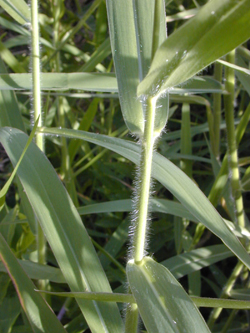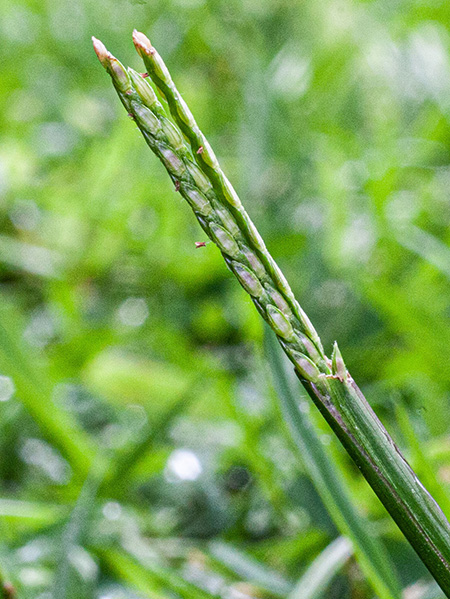|
|
|
[INFLORESCENCE SIMPLE RACEMES continued] |
|
|
|
|
42a
|
( 39) 39) |
 Lower racemes often secondarily branched. Large, perennial grass with hairy culms up to 18 ft (6 m) long, laying down and rooting at lower nodes. Sheath and culm densely hairy, collar velvety pubescent (see Fig. 5F), ligule membranous, or membranous topped by tightly set hairs. { Forming dense mats in wet areas, including wetlands and along streams and over ponds. California grass, Para grass [HAW - NAT] [GUM - NAT] [FACW]
Lower racemes often secondarily branched. Large, perennial grass with hairy culms up to 18 ft (6 m) long, laying down and rooting at lower nodes. Sheath and culm densely hairy, collar velvety pubescent (see Fig. 5F), ligule membranous, or membranous topped by tightly set hairs. { Forming dense mats in wet areas, including wetlands and along streams and over ponds. California grass, Para grass [HAW - NAT] [GUM - NAT] [FACW] Urochloa mutica (Forssk.) Nguyen
Figure 5F. Close up of the leaf of U. mutica showing the numerous long hairs on the blade and sheath margins. If hairs come off easily causing skin irritation, grass is probably Guinea grass, NOT California grass.
|
|
|
42b
|
|
Racemes narrow, simple, not secondarily branched. Grass not large; if spreading, then by stolons, not horizontal culms. .. .
|
|
[43]
|
|
~~~~ ~~~~~~~~~~~~~~~~~~~~~~~~~
|
|
43a
|
(42) |
 Rachis three-sided, the two spikelet-bearing faces about as broad as a spikelet; spikelets arranged singly, alternating faces, each on a very short (or no) pedicel, compressed and appressed into the undulating rachis. Although first glume missing, second glume and similar sterile lemma completely enclose (and extend beyond) the fruit. Ligule a low membrane with a fringed (ciliolate) edge. { Plant resembling a Digiteria, but the culm and lower raceme of the inflorescence often surrounded by a leaf sheath (tardily exserted; see Figure 5H). Axonopus spp. .. . Rachis three-sided, the two spikelet-bearing faces about as broad as a spikelet; spikelets arranged singly, alternating faces, each on a very short (or no) pedicel, compressed and appressed into the undulating rachis. Although first glume missing, second glume and similar sterile lemma completely enclose (and extend beyond) the fruit. Ligule a low membrane with a fringed (ciliolate) edge. { Plant resembling a Digiteria, but the culm and lower raceme of the inflorescence often surrounded by a leaf sheath (tardily exserted; see Figure 5H). Axonopus spp. .. .
|
|
[47]
|
|
43b
|
|
Rachis broad or narrow, flat or slightly curved with either a rounded or angular midrib, or lacking a continuous midrib separating spikelets. Spikelet arrangement on rachis variable, in singles or pairs (or more). Glumes not as above. Ligule a membrane or a fringe of short hairs or absent .. .
|
|
[44]
|
|
~~~~ ~~~~~~~~~~~~~~~~~~~~~~~~~
|
|
44a
|
(43) |
Spikelets elliptic to elongate, arranged singly, alternating sides, each on a very short pedicel OR spikelets in pairs, one on a short and the other on a long pedicel, although in some Digitaria, three or four grouped together possible near the middle of the raceme. Ligule present .. .
|
|
[45]
|
|
44b
|
|
Spikelets elliptic to subglobose, arranged in pairs or clusters of up to 7 on branched pedicel and appearing arranged more or less in rows. Spikelets with slightly inflated, curved hairs along edges and veins of second glume and first lemma. Ligule absent or a simple line of hairs. Echinochloa spp. .. .
|
|
[49]
|
|
~~~~ ~~~~~~~~~~~~~~~~~~~~~~~~~
|
|
45a
|
(44) |
 Racemes (2)3-5, short, spreading, spaced apart, and typically angled out or somewhat downward off culm. Raceme rachis three-sided, narrower on each face than spikelets, which alternate singly on short, broad pedicels. Spikelets elliptic, plump, glabrous, 2.4-3.7 mm long, first glume clasping lower 1/3 of spikelet. Ligule a line of tightly-packed, long cilia. { Small, light green to gray-green creeping perennial with short leaves, found in lawns and pastures. [HAW - NAT] [GUM - IND] Racemes (2)3-5, short, spreading, spaced apart, and typically angled out or somewhat downward off culm. Raceme rachis three-sided, narrower on each face than spikelets, which alternate singly on short, broad pedicels. Spikelets elliptic, plump, glabrous, 2.4-3.7 mm long, first glume clasping lower 1/3 of spikelet. Ligule a line of tightly-packed, long cilia. { Small, light green to gray-green creeping perennial with short leaves, found in lawns and pastures. [HAW - NAT] [GUM - IND]Urochloa distachya (L.) T.Q. Nguyen
|
|
|
45b
|
|
Rachis with either a rounded or angular midrib, or rachis narrowly winged without a clear midrib. Some spikelets grouped (two or more arising from a common point on the rachis) on pedicels of different lengths; First glume not clasping .. .
|
|
[46] |
|
~~~~ ~~~~~~~~~~~~~~~~~~~~~~~~~
|
|
46a
|
(45) |
 Spikelets 3-4 mm long, alternate singly along narrow rachis, on thin pedicels, or are paired with one on a short pedicel that branches off a long pedicel. First glume reduced to a bead-like (often contrasting purple and white) cuff or callus at base of spikelet. Ligule a short, dense row of hairs. Eriochloa spp. .. . Spikelets 3-4 mm long, alternate singly along narrow rachis, on thin pedicels, or are paired with one on a short pedicel that branches off a long pedicel. First glume reduced to a bead-like (often contrasting purple and white) cuff or callus at base of spikelet. Ligule a short, dense row of hairs. Eriochloa spp. .. .
|
|
[51] |
|
46b
|
|
Spkelets under 3 mm long; if grouped (two or more arising from a common point on the rachis) their pedicels together but not branching); pedicels of different lengths. First glume may be absent or much reduced in size, but neither clasping nor forming a bead-like callus at base of spikelet. Ligule a membrane. Digitaria spp. .. .
|
|
[35]
|
|
~~~~ ~~~~~~~~~~~~~~~~~~~~~~~~~
|
|
47a
|
(43) |
Culm joints without hairs (glabrous). Leaf blades linear, flat or folded, never wavy. Inflorescence on long peduncle above terminal sheath. Spikelets elliptic or narrowly obovate, appressed to rachis in two rows on 2 to 7 spikes; spikelets without pedicels; glume and lemma faces with marginal veins only. { Small, perennial, spreading grass; very widespread in lawns, along trails and roads. Narrow-leaved carpetgrass [HAW - NAT] [FAC]Axonopus fissifolius (Raddi) Kuhlm.
|
|
|
47b
|
|
 Culm joints hairy. Leaf blade rather broad, margins typically wavy, tips rounded. Initially, inflorescence extending only a little above terminal sheath. Spikelets elliptic or narrowly obovate, appressed to rachis in two rows on 2 to 5 spikes; spikelet pedicels very short (see Fig. 5I). { Small, perennial, spreading grass typically volunteering in lawns, but now widely seen as a lawn grass, dominating especially in moist and somewhat shadey locations. Broad-leaved carpetgrass [HAW - NAT] [GUM - NAT]
Culm joints hairy. Leaf blade rather broad, margins typically wavy, tips rounded. Initially, inflorescence extending only a little above terminal sheath. Spikelets elliptic or narrowly obovate, appressed to rachis in two rows on 2 to 5 spikes; spikelet pedicels very short (see Fig. 5I). { Small, perennial, spreading grass typically volunteering in lawns, but now widely seen as a lawn grass, dominating especially in moist and somewhat shadey locations. Broad-leaved carpetgrass [HAW - NAT] [GUM - NAT]Axonopus compressus (Swartz) P. Beauv.
Figure 5G. Close up of A. compressus inflorescence emerging from bladeless leaf sheat. Blade is typically short; bladeless condition results from lawn mowing. An enlarged version of this photo is at Fig. 5H, befow.
|
|
|
~~~~ ~~~~~~~~~~~~~~~~~~~~~~~~~
|
|
48a
|
(38) |
Inflorescence oblong to ovoid with numerous racemes held more or less vertical (appressed or ascending). Spikelets narrowly obovate, 1/8 to 1/3 in (3-8 mm) long, pressed against rachis and with 5 to 9 imbricated florets. Glumes hyaline with a single, prominent central vein. Ligule a tall membrane. { Medium size, clumping annual; usually found in wet sites or dry areas associated with ephemeral standing water. Sprangletop [HAW - NAT]Diplachne fusca (L.) Stapf ssp. uninervia (J. Presl) P.M. Peterson & Snow
|
|
|
48b
|
|
Inflorescence more lax, racemes long and bending. Spikelet of 2 or 3, 1-mm long florets, these separated: slightly larger basal spikelet sessile, other(s) on a rachilla rising above the glumes. Glumes spreading, similar in length (just exceed basal spikelet) but dissimilar in shape: lower narrow, acute, upper broadly obtuse. { small, clumping annual. Reported from Saipan. [HAW - NAT]Leptochloa panicea (Retz.) Ohwi.
|
|
|
~~~~ ~~~~~~~~~~~~~~~~~~~~~~~~~
|
|
49a
|
(44) |
Spikelets with apex acute or tipped with a sharp point (cuspidate), not awned (Fig. 5A). Racemes up to 3 cm (1.25 in) long, arranged singly along the culm, widely spaced below; spikelets forming 4 regular rows. { Small to medium, annual, tufted grass; in wet areas. Jungle-rice [HAW - NAT] chaguan-agaga [GUM - NAT]Echinochloa colona (L.) Link
|
|
|
49b
|
|
Spikelets with apex prolonged into a point and usually with a short to long awn .. .
|
|
[50]
|
|
~~~~ ~~~~~~~~~~~~~~~~~~~~~~~~~
|
|
50a
|
(49) |
Racemes 3/4 in to 4 in (2-10 cm) long, congested on the culm. Spikelets in two to several untidy rows. { Small to medium, annual, tufted grass; in wet areas and along waterways. Barnyard grass [HAW - NAT]Echinochloa crusgalli (L.) P. Beauv.
|
|
|
50b
|
|
Ligule absent or a line of hairs. Lanceolate inflorescence (somewhat foxtail-like) of racemes 1/2 in to 2 in (1-5 cm) long, very congested on the culm. Spikelets in several untidy rows. { medium-size, perennial, densely tufted grass; in wet areas (O‘ahu, Ka Iwi). [HAW - NAT]Echinochloa haploclada (Stapf) Stapf
|
|
|
|
~~~~ ~~~~~~~~~~~~~~~~~~~~~~~~~
|
|
51a
|
(46) |
 Spikelets with apex of lemma prolonged about 1-1.5 mm as a short awn. Racemes (3)6-8, short, spreading or appressed, spaced apart. Spikelets 3.3-5 mm long, elliptic, with silky hairs plus (or not) long hairs (cilia) nearly as long as spikelet arising just below very distinctive callus (see Fig. 5J, below). { Small to medium perennial in wet, disturbed sites. Cupgrass [HAW - NAT] Spikelets with apex of lemma prolonged about 1-1.5 mm as a short awn. Racemes (3)6-8, short, spreading or appressed, spaced apart. Spikelets 3.3-5 mm long, elliptic, with silky hairs plus (or not) long hairs (cilia) nearly as long as spikelet arising just below very distinctive callus (see Fig. 5J, below). { Small to medium perennial in wet, disturbed sites. Cupgrass [HAW - NAT]Eriochloa punctata (L.) Desv. ex W. Ham.
|
|
|
51b
|
|
Spikelets with apex of lemma acute or tipped with a sharp point (cuspidate), but not a short awn. Racemes 3-10, short, spreading, spaced apart. Spikelets 2.5-4 mm long, narrow elliptic, with sparse silky hairs; pedicels and rachis mostly without hairs. { Small, annual in wet, disturbed sites. Cupgrass [HAW - NAT] Eriochloa procera (Retz.) C.E. Hubb.
|
|